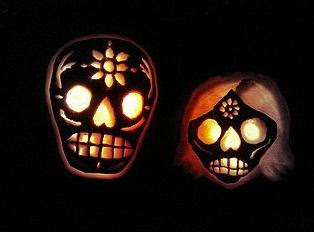Mexico’s Day of the Dead, Dia de los Muertos
Mexico’s Día de los Muertos, or Day of the Dead, often gets confused with the American holiday that comes around the same time. While Halloween and Día de los Muertos share some connections, they aren’t synonymous.
The two-day celebration, All Saints Day, November 1st and then the Day of the Dead, November 2nd, is a joyous time where people remember the lives of their deceased relatives. They may go and clean the tombstones of those who have passed and perhaps plan a picnic in the graveyard even preparing their loved ones’ favorite foods to eat. Skulls are also a part of the holiday decorations, both paper and edible varieties. Sugar candy skulls, or calaveras de dulce, are widely available and include intricate, colorful designs (see feature photo).
The history of the Day of the Dead dates back to ancient Aztec and Mayan times. The original tradition was a month-long festival in August dedicated to a goddess called the Lady of the Dead. Historians note that when the Spaniards first came to Mexico, they brought with them Catholic beliefs and holidays, including All Hallows or All Saints Day. The day before All Saints Day was All Hallow’s Eve. Sound familiar? That day, October 31st, became Halloween, which children all over America celebrate today. It’s interesting to note that Mexicans sometimes carve pumpkins with skulls on them for the Day of the Dead. Pumpkins are prized in Mexico; in fact, archeologists found the oldest known pumpkin seed—estimated to date back to 7,000 B.C. in a tomb in central Mexico.

To help your children understand more about this important Mexican tradition, you might visit the library where you may find at least a few good picture books about the holiday. I read, Pablo Remembers: The Fiesta of the Day of the Dead by George Ancona and El Dia de los Muertos by Mary Dodson Wade, with my 9 year-old. Both use simple explanations to guide children through understanding how Mexicans honor their relatives as part of the holiday.
I especially liked Ancona’s book since it follows a young boy, Pablo, as he recalls his grandmother on the Day of the Dead. It helped my daughter relate to Pablo’s experiences. She first picked up the book because she was struck by boy on the cover who was smiling with his hands holding a sugar-coated skull, his name written on it. The book includes several Spanish words that relate to the festivities, like velas for candles, and copal for incense. We reviewed those aloud together (although I have no gift for pronunciation). I read with interest the Note from the Author, which includes a history of the holiday and concludes, “To Mexicans the fiesta of the Day of the Dead is both a public holiday and a private one. Publicly, the community makes light of death and pokes fun at it. Privately, people honor the memories of their deceased family members.”
At our house, we decided to create our own dessert to celebrate the Day of the Dead using some of our favorite tastes and flavors of fall. I had my oldest daughter use a pizza cutter to make thin strips of flour tortillas (we used about five 8” tortillas). I then fried the tortillas until crisp in oil, although you could also bake the strips in the oven. She then sprinkled them with cinnamon and sugar. As a dip for our crispy cinnamon strips we whisked one part Greek yogurt with two parts pureed, canned pumpkin. I used about ½ cup Greek yogurt with 1 cup pumpkin and then stirred in ½ tablespoon sugar and 1 heaping teaspoon of cinnamon (if I’d had pumpkin pie spice, I would have used that). I topped the pumpkin mix with toasted pecans and let me kids dip away. As we ate, we talked about The Day of the Dead. But I must admit the conversation soon turned to what each one of them was planning on being for Halloween.
Kristen J. Gough is the Global Cuisines & Kids Editor for Wandering Educators.
Feature photo courtesy Comida Mexicana
Skull photo courtesy Hispanic Culture Online
Day of the Dead dessert photo courtesy Kristen J Gough
-

- Log in to post comments




















Terry at Overni...
Nice fact-filled post about a fascinating holiday. Your dessert sounds intriguing. My local bakery makes pan de los muertos, bread loaves that look like big babies, tinted pink. Haven't tied one yet, but I'm tempted.